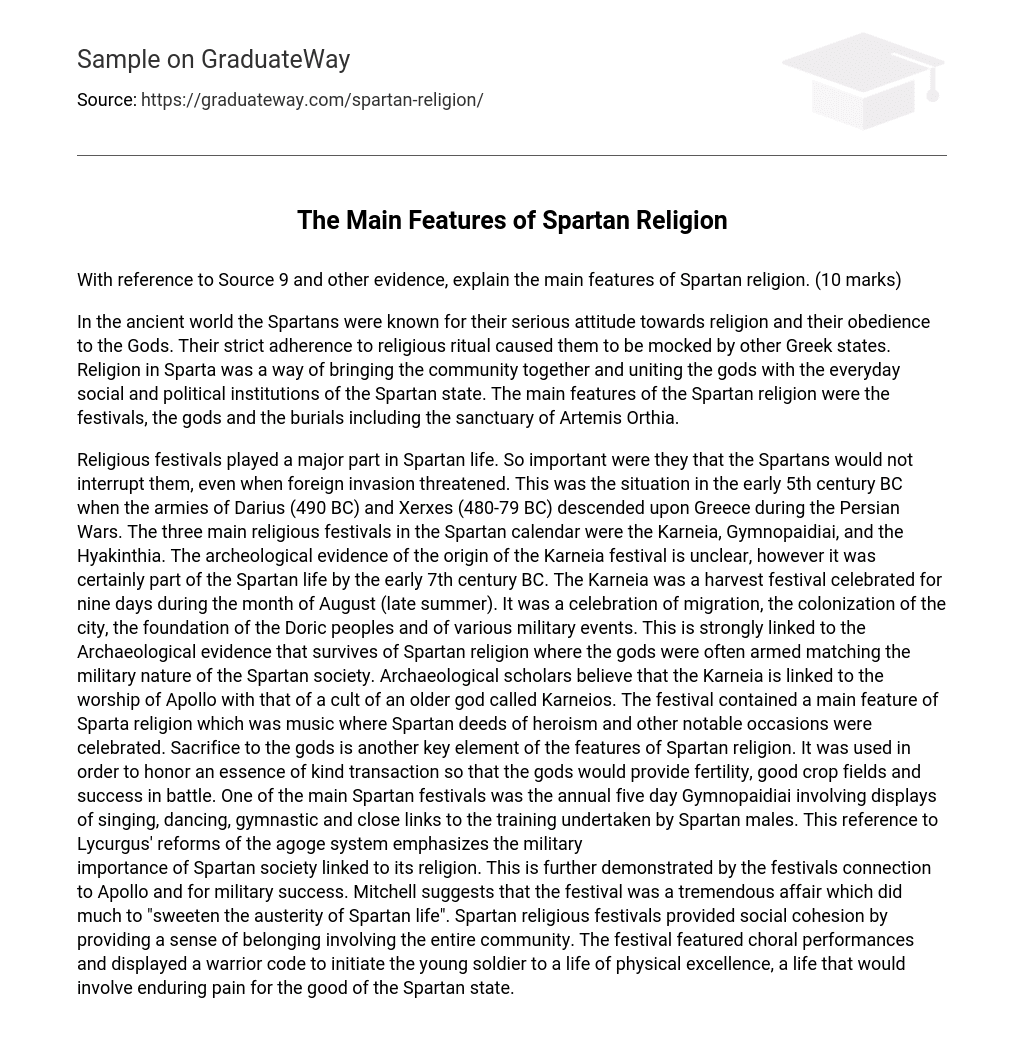With reference to Source 9 and other evidence, explain the main features of Spartan religion. (10 marks)
In the ancient world the Spartans were known for their serious attitude towards religion and their obedience to the Gods. Their strict adherence to religious ritual caused them to be mocked by other Greek states. Religion in Sparta was a way of bringing the community together and uniting the gods with the everyday social and political institutions of the Spartan state. The main features of the Spartan religion were the festivals, the gods and the burials including the sanctuary of Artemis Orthia.
Religious festivals played a major part in Spartan life. So important were they that the Spartans would not interrupt them, even when foreign invasion threatened. This was the situation in the early 5th century BC when the armies of Darius (490 BC) and Xerxes (480-79 BC) descended upon Greece during the Persian Wars. The three main religious festivals in the Spartan calendar were the Karneia, Gymnopaidiai, and the Hyakinthia. The archeological evidence of the origin of the Karneia festival is unclear, however it was certainly part of the Spartan life by the early 7th century BC. The Karneia was a harvest festival celebrated for nine days during the month of August (late summer). It was a celebration of migration, the colonization of the city, the foundation of the Doric peoples and of various military events. This is strongly linked to the Archaeological evidence that survives of Spartan religion where the gods were often armed matching the military nature of the Spartan society. Archaeological scholars believe that the Karneia is linked to the worship of Apollo with that of a cult of an older god called Karneios. The festival contained a main feature of Sparta religion which was music where Spartan deeds of heroism and other notable occasions were celebrated. Sacrifice to the gods is another key element of the features of Spartan religion. It was used in order to honor an essence of kind transaction so that the gods would provide fertility, good crop fields and success in battle. One of the main Spartan festivals was the annual five day Gymnopaidiai involving displays of singing, dancing, gymnastic and close links to the training undertaken by Spartan males. This reference to Lycurgus’ reforms of the agoge system emphasizes the military
importance of Spartan society linked to its religion. This is further demonstrated by the festivals connection to Apollo and for military success. Mitchell suggests that the festival was a tremendous affair which did much to “sweeten the austerity of Spartan life”. Spartan religious festivals provided social cohesion by providing a sense of belonging involving the entire community. The festival featured choral performances and displayed a warrior code to initiate the young soldier to a life of physical excellence, a life that would involve enduring pain for the good of the Spartan state.
The Sanctuary of Artemis Orthia was built near the banks of the Eurotas River, near the ancient town of Limnon. It was one of the most significant sanctuaries of the Spartan cult and was associated with the education of young Spartans. Early on, the deity worshipped was referred to as Orthia’s who was considered the goddess of salvation and fertility, as well as the protector of vegetation. Later on, the cult was linked to that of Artemis and the temple became a centre of religious education for young people. During the Imperial Period, it served as the site of bloody spectacles performed in accordance to the customs of the time. The oldest relics found in this site, which can be shown through source 9, are pottery fragments from the late Greek Dark Ages, indicating that the cult has probably existed since the 9th century BC. In about 700 BC a temple had been built within a paved enclosed area. It continued to be important for centuries. As conveyed in source 9, the area was open and bare and was surrounded by fertile land of trees and plains. The offerings at the early sanctuary, although small, were often made from expensive and exotic materials brought from far away, such as amber and faience, gold, silver and bronze. This emphasizes its prowess and importance on Spartan society and marks a main religious feature of Sparta. The source also reveals the ruins of the temples, altars and an area for spectators.





